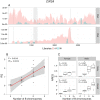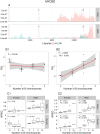Protein-coding genes in B chromosomes of the grasshopper Eyprepocnemis plorans
- PMID: 28367986
- PMCID: PMC5377258
- DOI: 10.1038/srep45200
Protein-coding genes in B chromosomes of the grasshopper Eyprepocnemis plorans
Abstract
For many years, parasitic B chromosomes have been considered genetically inert elements. Here we show the presence of ten protein-coding genes in the B chromosome of the grasshopper Eyprepocnemis plorans. Four of these genes (CIP2A, GTPB6, KIF20A, and MTG1) were complete in the B chromosome whereas the six remaining (CKAP2, CAP-G, HYI, MYCB2, SLIT and TOP2A) were truncated. Five of these genes (CIP2A, CKAP2, CAP-G, KIF20A, and MYCB2) were significantly up-regulated in B-carrying individuals, as expected if they were actively transcribed from the B chromosome. This conclusion is supported by three truncated genes (CKAP2, CAP-G and MYCB2) which showed up-regulation only in the regions being present in the B chromosome. Our results indicate that B chromosomes are not so silenced as was hitherto believed. Interestingly, the five active genes in the B chromosome code for functions related with cell division, which is the main arena where B chromosome destiny is played. This suggests that B chromosome evolutionary success can lie on its gene content.
Conflict of interest statement
The authors declare no competing financial interests.
Figures



Similar articles
-
Transcription of a B chromosome CAP-G pseudogene does not influence normal Condensin Complex genes in a grasshopper.Sci Rep. 2017 Dec 15;7(1):17650. doi: 10.1038/s41598-017-15894-5. Sci Rep. 2017. PMID: 29247237 Free PMC article.
-
Ribosomal DNA is active in different B chromosome variants of the grasshopper Eyprepocnemis plorans.Genetica. 2013 Sep;141(7-9):337-45. doi: 10.1007/s10709-013-9733-6. Epub 2013 Sep 6. Genetica. 2013. PMID: 24008810
-
B-chromosome ribosomal DNA is functional in the grasshopper Eyprepocnemis plorans.PLoS One. 2012;7(5):e36600. doi: 10.1371/journal.pone.0036600. Epub 2012 May 3. PLoS One. 2012. PMID: 22570730 Free PMC article.
-
The B chromosomes of the grasshopper Eyprepocnemis plorans and the intragenomic conflict.Genetica. 2003 Jan;117(1):77-84. doi: 10.1023/a:1022311320394. Genetica. 2003. PMID: 12656575 Review.
-
Cytogeography and the evolutionary significance of B chromosomes in relation to inverted rearrangements in a grasshopper species.Cytogenet Genome Res. 2004;106(2-4):351-8. doi: 10.1159/000079312. Cytogenet Genome Res. 2004. PMID: 15292616 Review.
Cited by
-
First characterization of PIWI-interacting RNA clusters in a cichlid fish with a B chromosome.BMC Biol. 2022 Sep 21;20(1):204. doi: 10.1186/s12915-022-01403-2. BMC Biol. 2022. PMID: 36127679 Free PMC article.
-
Characterization of the satellitome in lower vascular plants: the case of the endangered fern Vandenboschia speciosa.Ann Bot. 2019 Mar 14;123(4):587-599. doi: 10.1093/aob/mcy192. Ann Bot. 2019. PMID: 30357311 Free PMC article.
-
Genomic Characterization of a B Chromosome in Lake Malawi Cichlid Fishes.Genes (Basel). 2018 Dec 5;9(12):610. doi: 10.3390/genes9120610. Genes (Basel). 2018. PMID: 30563180 Free PMC article.
-
Low-pass single-chromosome sequencing of human small supernumerary marker chromosomes (sSMCs) and Apodemus B chromosomes.Chromosoma. 2018 Sep;127(3):301-311. doi: 10.1007/s00412-018-0662-0. Epub 2018 Jan 30. Chromosoma. 2018. PMID: 29380046
-
Gene expression changes elicited by a parasitic B chromosome in the grasshopper Eyprepocnemis plorans are consistent with its phenotypic effects.Chromosoma. 2019 Mar;128(1):53-67. doi: 10.1007/s00412-018-00689-y. Epub 2019 Jan 7. Chromosoma. 2019. PMID: 30617552
References
-
- Puertas M. J. et al.. Genetic control of B chromosome transmission in maize and rye. In Chromosomes Today(eds Olmo P. D. E. & Redi P. C. A.) 79–92 (Birkhäuser Basel, 2000).
-
- Camacho J. P. M. B chromosomes. In The Evolution of the Genome(ed. Gregory T. R.) 223–286 (Academic Press, 2005).
-
- Graphodatsky A. S. et al.. The proto-oncogene C-KIT maps to canid B-chromosomes. Chromosome Res. 13, 113–122 (2005). - PubMed
Publication types
MeSH terms
Substances
LinkOut - more resources
Full Text Sources
Other Literature Sources
Miscellaneous

